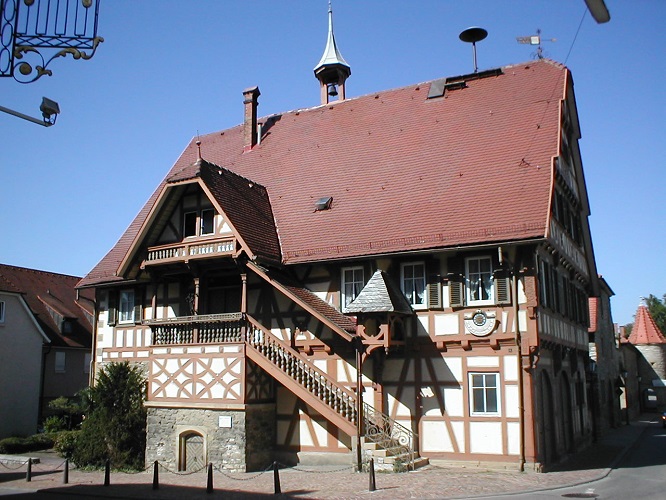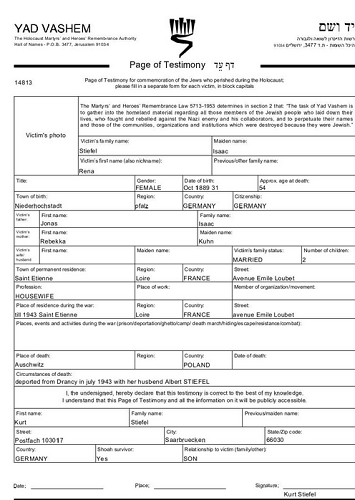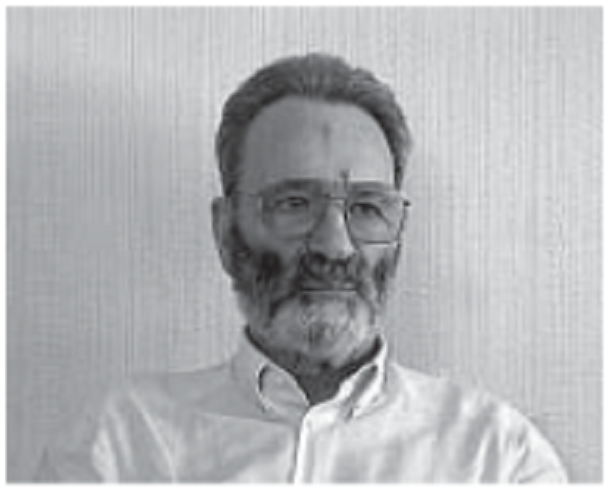
Footnote 1 – Ancestry
When Margaret took Bruce and Vivian on our “roots” trip in 1968, she took us to Bad Wimpfen and said that was where Willy was born. Willy actually was born in Kochendorf (now part of Bad Friedrichshall), famous for its salt mines and right across the Neckar River from Bad Wimpfen. Willy’s father Louis had an ironmongery / building materials / hardware store there until 1921 or 1922 and another one in Heilbronn after 1885.
Siegmund Maier, Selma’s sister Emma’s husband actually was born in Bad Wimpfen, as were their four children: Louis, Wilhelm, Alfred and Alice. They then moved to Heilbronn, from where they traded horses with Belgium.
Footnote 2 – Good Germans & Good Jews
The Weisburgers had three businesses in Stuttgart that we know about.
1. Wilhelm Weissburger am Bollwerk at 46 Gartenstrasse, selling stoves, furnaces, washing machines. In his testimony to the Shoah Foundation, John says that Selma managed this business starting in 1927, that they sold kitchen equipment, stoves and refrigerators, and that she was a “good sales lady”. Perhaps she took over this business when Willy started to be involved with the Bund.
The Bulwark is a geological formation in West Stuttgart, with good conditions for commercial gardens. Perhaps this neighborhood is where the piano teacher’s apartment was.
2. Willy was president of the Stuttgarter Bund [Puchasing Association] GmbH [LLC] Einkaufsverband [Commercial Association] in the Mittnachtbau at 46 Königstrasse in downtown Stuttgart.
Erna says, “He was director of a buying concern [for] hardware, household and gift shops. Anything new that came out in Dusseldorf in the exhibitions, he got it. He had to go to the exhibitions to see what’s out new and then display it in his showrooms for the trade to see … I don’t know if [the customers were] retailers or wholesalers. I can’t tell you. He had a top salary …”
John, in his testimony to the Shoah Foundation, says that the Bund sold to hardware stores, and had an “imposing showroom”. Department stores were their competitors and came in with volume purchases. Willy’s ’s idea was to get “retail stores together to get volume discounts”.
The Mittnachtbau opened in 1928. Willy was given power of attorney for the Bund on 1929-07-06. Perhaps this was when the family moved to 28 Lerchenstrasse, fairly nearby.
3. Selma had her own business too after the move downtown. According to John in his 1994 interview with Bruce, it sold stoves and refrigerators, and was located on Seidenstrasse near a plaza with a park [Berlinerplatz?] and near the Bosch factory. He could walk there from school. According to Erna, “she opened her own business, which was bathrooms, insulation, stoves, anything related with it. And she made good money.”
This sounds like a continuation of the business in West Stuttgart that she was managing.
Footnote 3 – Brussels
The dying and dry cleaning plant was confiscated by the nazis and then sold in 1944. According to Filip Strubbe at the Belgian National Archive:
After the liberation, the Belgian authorities annulled the effects of the Nazi racial laws, meaning that persons of Jewish origin who had been stripped of their nationality once again became German. But paradoxically, this meant that many persons of Jewish origin were considered as “enemy nationals” and their properties were therefore sequestered. Now a sequestration isn’t a confiscation: it only meant that the owner of a house or any other real estate could no longer freely dispose of his or her property, like selling it (although they could still inhabit it). This is what happened to Wilhelm Weissburger’s property.
In the summer of 1946 when they really needed the money, Willy applied for this sequestration to be lifted but was denied. I remember John grumbling about this ridiculous situation of being denied rights to their property because they were considered German citizens. I didn’t realize that it was this property in Brussels that he was talking about.
Belgian authorities knew about the persecutions of Jews that had taken place during the war but it wasn’t until late 1947 that there was a legal possibility to lift the sequestration of properties belonging to persons of Jewish origins (if their conduct during WW II had been OK) … in 1948, the sequestration was lifted.
For future family historians:
- there may be a trace of this German sequestration in the archives of my colleagues at the National Archives 2 (Cuvelier repository)
- The archives of the Verwaltung des jüdischen Grundbesitzes,, series Muller, contain a file (nr. 912) on a real estate belonging to Wilhelm Weissburger, situated in the Avenue Van Volxhem nr. 12 [this was the dry cleaning factory] in Forest (which is part of the Brussels agglomeration). It’s not the same address as the one in the foreigners’ file [their apartments], but it’s in the same neighborhood.
- As for the postwar sequestration itself, my colleagues may also conserve a sequestration file (the reference number of which is indicated in the correspondence within the foreigner’s file: “ENN 5919”): “series enemies, file nr. 5919”. This series is known for its many gaps, but its’ worth giving it a try by contacting my colleagues and providing them with these references.
Footnote 4 – Flight thru France – St Etienne
In Margaret’s autobiography, she says “we moved on to Saint-Etienne, a French miner town, where my father [Willy] had some relatives.” In John’s testimony to the Shoah Foundation and in his 2007 interview with me, he says that Willy had a cousin in St Etienne.
Who was this cousin?
I got a hint when I was checking the Yad Vashem database of people murdered by the nazis against everyone on Margaret’s 1977 family tree from my grandparent’s and my mother’s generation.
Albert Stiefel, one of Willy’s cousins on his mother’s side, was deported from France on 1943-07-31 and was murdered in Auschwitz. His wife, Rena (Isaac) Stiefel was deported on the same day and was also murdered in Auschwitz, but for her there is a testimony from her son Kurt, including that she lived on ave Emile Loubet in St Etienne during the war.
According to Margaret’s family tree, Albert and Rena had two children: Jules in France and Max in Israel. Might Jules be going by the name Kurt?
Three of the grandchildren of Adolf Siefel are named Kurt. Jules’s grandfather Joseph Stiefel was Adolf’s brother. There is a Jewish custom of naming children after someone in their grandparent’s generation, so maybe Kurt was Jules’s middle name that he adopted after the war.
I searched the internet for a Kurt Stiefel living in France, and there he was!
in 2002:
Kurt Stiefel, Saarbrücken, was born in 1921. The family lived in Bruchsal [Baden, Germany] at the time, where they ran a cigar factory. When the family fell victim to the global economic crisis, the family moved to Saarbrücken [capital of Saarland, independent after WWI], where the father worked as a tobacco salesman.
This family adhered to the rules of the Jewish religion very closely.
In the run-up to the Saar referendum [to decide whether to remain independent or rejoin Germany], Kurt Stiefel suffered immediate discrimination. He was expelled from the high school and lost two apprenticeship positions. His father’s holdings were terminated and the family left Saarbrücken on February 29, 1936.
The parents bought a textile shop in Saint-Étienne [France], and Mr Stiefel and his brother went to school there. After the German invasion, the Vichy government expropriated the family’s business.
Herr Stiefel reported to the Chantiers de Jeunesse [Young Construction Workers], a state labor service. Employed in the Isère department, he was able to hide his Jewish origins. After the occupation of all of France, the parents tried to get to their son and with his help to hide. On the way they were arrested by military policemen and taken to Drancy (the assembly camp near Paris). From there they were deported to Auschwitz, where they were murdered.
Herr Stiefel entered the Garde Républiquaine in 1944, concealing his origins, and so came to Paris, where he, protected by his uniform, escaped the last raids.
After the German capitulation, he was an occupying gendarme in Austria. To avoid the War in Vietnam, he said goodbye and founded a book and magazine distributor in Sarreguemines [France] (German: Saargemünd – not far from Saarbrücken), which supplied the Saarbrücken bookshops with Austrian books with French import licenses.
Some time later he went to Paris, where he worked in the travel industry.
In 1968 he married the daughter of a Saarbrücken family who had also survived in exile in France. So he came back.
The Stiefel couple have a son who lives in France.
He was also a founding member of the Christian-Jewish Working Group of Saarland eV (CJAS). He died in 2012 at the age of 91.
I sent an email to Professor Herbert Jochum, the president of the CJAS in 2021, asking him to put me in touch with Kurt’s son. Kurt’s wife Eva was still alive in assisted living in Strasbourg [France| and he forwarded my email to Kurt’s son Daniel.
I never got a reply.
I also tried the genealogy website Geni.com to track down a rather distant Stiefel relative – Karyn Blass, the great granddaughter of Adolf, the brother of Jules’s / Kurt’s grandfather’s Joseph – who lives in Israel. This also did not get very far.
So the question of whether Kurt is really Jules remains for a future family historian.
4,539 total views, 15 views today








